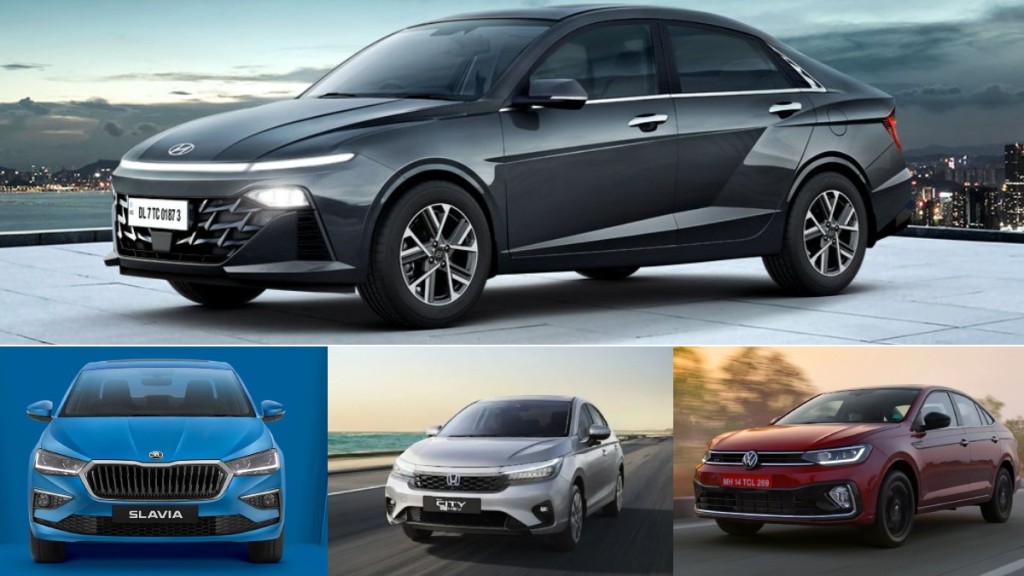The sedan segment is spiced up with the launch of the new generation Hyundai Verna. This latest offering from Hyundai has created a massive buzz in its segment. And is generating immense attention from audiences across the country. Let’s have a look at how it fares against its rivals: –

Hyundai Verna vs Honda City
Honda City has been a prominent sedan in this segment. This sedan has been ticking all the boxes of customer needs. The overall design of the Hyundai Verna is more sophisticated yet polarizing. Meanwhile, the overall design of Honda City is sedate and elegant. The 5th gen Honda City is the first in the segment to get the ADAS safety feature. But the Verna gets segment first switchable type button for infotainment and AC controls. The city offers Adaptive Cruise Control, Autonomous Emergency Braking and Brake Assist which Verna doesn’t offer it. The Verna gets Front Parking Sensors, Emergency Brake Lights and Rear Cross Traffic Alert Which City lacks it.
When it comes to comfort, the Verna offers Ventilated seats and a longer wheelbase than City. And, the new-gen Verna is more practical with 528 litres of boot space than 506 litres of City. In terms of engines, Verna offers a more thrilling drive with an option of a 4-cylinder Turbo GDi. However, the City can conserve more fuel with an option of a 4-cylinder Hybrid engine.
Hyundai Verna vs Volkswagen Virtus
Volkswagen Virtus is the successor of the enthusiast delight, Volkswagen Vento. However, the Virtus is a more practical car than its predecessor. The overall design language of Virtus is striking and sporty. Meanwhile, the Verna is designed towards Sophistication and Elegance. The new Verna offers a bigger boot space of 528 litres than the 521 litres of Virtus. The new Hyundai Verna is brimmed with plenty of safety features like lane departure warning and prevention, front collision warning, high-beam assist, blind spot detection and rear cross-traffic warning. Moreover, the safety of Verna is enhanced by front parking sensors. The new Verna also offers a leather-wrapped gear knob and sunglass holder. But Volkswagen Virtus offers 8-way adjustable seats and rear folding seats.
Both cars are available with powerful 1.5L 4-cylinder turbo petrol engines and 7-Speed DCT gearboxes. But Verna offers more power at 160ps than 150ps of Virtus. And an option of a true and enthusiastic 6-Speed Manual Gearbox with Turbo Petrol which the Virtus lacks. However, Virtus offers a 1.0L TSi engine which makes more torque than the 1.5L VTVT engine of Verna. Virtus also offers a 6-Speed Torque Converter Automatic Gearbox but Verna has an IVT gearbox. The Virtus will offer less traction with a limited-slip differential and can conserve fuel with the ACT feature. The Active Cylinder Technology feature shuts down the 2 cylinders of the engine to extract more mileage.
Hyundai Verna vs Skoda Slavia
Skoda Slavia is a successor to the Skoda Rapid which was another enthusiast delight. The overall design language of Slavia is bold and sleek. Meanwhile, Verna looks more Sophisticated and Polarizing. The new Verna offers a bigger boot space of 528 litres than the 521 litres of Slavia. The Skoda Slavia offers Passive Cornering Lights but Verna has normal Cornering lights. The new Hyundai Verna is brimmed with plenty of safety features like lane departure warning and prevention, front collision warning, high-beam assist, blind spot detection and rear cross-traffic warning. Moreover, the safety of Verna is enhanced by front parking sensors. But Skoda Slavia offers 8-way adjustable seats and rear folding seats.
Both cars are available with powerful 1.5L 4-cylinder turbo petrol engines and manual and DCT gearboxes. But Verna offers more power at 160ps than 150ps of Virtus. However, Slavia offers a 1.0L TSi engine which makes more torque of 178nm than the 144nm of the 1.5L VTVT engine of Verna. Skoda Slavia also offers a 6-Speed Torque Converter Automatic Gearbox but Verna has an IVT gearbox. The Slavia will offer less traction with a limited-slip differential and can conserve fuel with the ACT feature.
